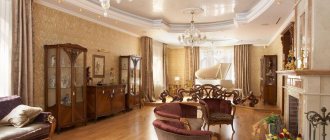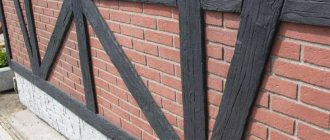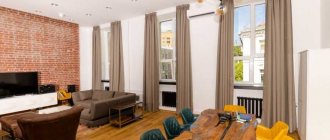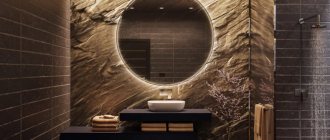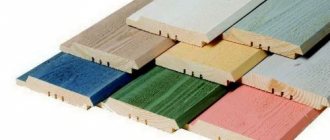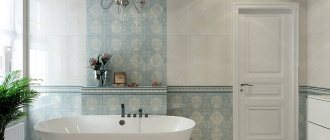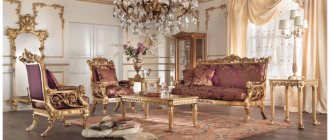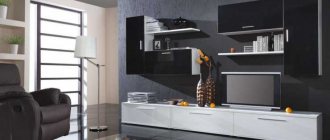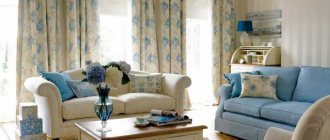Colonial style belongs to the group of classical styles. It received its name in honor of the colonists who, settling in foreign lands, not only brought with them their native traditions in interior design, but also borrowed customs from the local residents. In the direction, a balance was found between sophistication, luxury and laconicism, “native simplicity”. In fact, the colonial style in the interior is a combined eclectic potpourri, consisting of several ethnic branches. Each of them is characterized by certain features, but there are also general principles that unite these subgroups into one movement. Let's talk in this article about how to create a colonial interior in a city apartment or house with your own hands.
History of the origin of the style
A number of countries that in past centuries were located at the political “top of the world” could not boast of their own vast territories. Since their enrichment was largely due to the use of slave labor and the duping of the “backward” native population, rather than skillful management, they had to conquer more and more new territories. These countries primarily included Spain, Great Britain, France and the Ottoman Empire. After the discovery of “India” by Christopher Columbus, great prospects opened up for these states: two entire continents with rich lands and a population that was hung with gold, but did not know its real value. South and North America were “cut” into three parts, in which the native language of the colonialists is still spoken. The south went to Cortes and the bloody conquistadors, and the north was divided by the French and the British. The expansion and policy of colonialism obliged the metropolis to send military officers and governors who controlled the territories to their vassals. Since the period of residence could be tens of years, they moved with their families and settled down thoroughly. The interiors of the colonists' houses certainly contained features typical of their homeland, but at the same time local culture and features seeped into them, which made it possible to adapt to the unusual climate. The list of subject countries was not limited to mainland America. Great Britain at one time took under its wing part of Australia, New Zealand, Bangladesh, Seychelles, Mauritius, Barbados and a dozen other states that have now gained relative independence. France extended its “tentacles” to Syria, Morocco, Algeria, Chad, and Spain captured Manila, the Philippines, Guinea, part of the island of Taiwan and even the Sahara Desert. After the United States threw off the “yoke” of Mother Britain, the state followed in her footsteps and acquired Hawaii, the Philippines, Cuba, and Samoa. There was a colossal mixture of cultures, which subsequently resulted not in an unprepossessing potpourri with many ethnic elements, but in elegant, luxurious and original interiors.
The main directions of style and their distinctive features
Colonial style is an expensive pleasure that only people with above-average income can afford. The interiors use exclusively natural materials, which are now very expensive. General features of the direction include:
- Abundance of exotic vegetation. Colonization usually took place in tropical countries, which explains the use of “local” vines, ferns, and palm trees. Plants not only looked beautiful in homes, but also helped cool the hot air slightly.
- Wide floor-to-ceiling windows look more like doors. In colonial houses, openings were purposefully enlarged. To a large extent, this was done so that a pleasant draft appeared in the house.
- Use of natural wood and stone in exterior and interior decoration.
Although there are many substyles in the colonial direction, in our time only three of them have gained popularity:
- French;
- English;
- American.
The latter deserves special attention, since it is considered colonial “squared”, because before becoming a metropolis, the country itself was under the yoke of Britain for a long time. The direction is based on the classical style, which has expanded its boundaries. This was expressed in spacious (necessarily 2-3 storey) houses, where guests were greeted by a huge hall with a staircase. Solid wood prevailed in the materials, and the decor was made of forged metal. The English version of the style is an architectural and interior medley of Great Britain and India, which was its colony for a long time. The severity, stiffness and aristocracy of the British collided with the softness, openness and simplicity of the Indians. Classic interiors are complemented by “wild” trophies in the form of animal skins and heads on the walls, and Gothic features alternate with smooth, rounded lines and ornate patterns that used to decorate Hindu temples.
The French colonial style gave us the famous panoramic windows. In this direction, the clearest trace was left by mixing with Asian cultures. The interiors use silk wallpaper with thematic patterns, expensive porcelain, and metal decorative elements (boxes, vases).
American Colonial Style House
It is difficult to identify any common features for the American colonial style. In fact, the American colonial style is made up of many individual styles, and this diversity is directly related to the diversity of the national composition of emigrants from Europe who originally populated America. In America there are houses based on various variations of English style (Victorian, Gregorian and many others), French, Danish, Spanish and many others.
Let's pay attention to the architecture of classic American mansions that wealthy people built for themselves starting in the mid-19th century.
The architecture of these houses sufficiently reflects the features of the colonial style of old America.
These were quite horizontally extended houses. There was no point in building many floors, and the size of the house was supposed to demonstrate the degree of wealth of its owner. At the same time, the building was built strictly symmetrical. The entrance is in the center and is reached by a large staircase. Often such staircases were made of marble and complemented with patterned railings.
Exterior of American Colonial style houses
- The façade usually had many windows.
- The roof is sloping or attic, with dormer or attic windows.
- It is characteristic that, despite the desire to flaunt their wealth, Americans are quite stingy with architectural decorations. The rich appearance of the house is achieved with the help of high-quality finishing materials and the overall scope of construction.
- There are practically no relief decorations in American colonial houses.
- The finishing of facades is most often made of white or colored plaster.
Cape Cod
It would also be appropriate to consider the simplest version of the American colonial style - this is the style called Cape Cod.
It is widespread throughout the country; we can often see such houses in American films about life in the suburbs or the provinces.
For Americans, Cape Cod is a unique symbol and the quintessence of the “real” America. This was the first style most often used in construction by English colonists. Cape Cod style homes were built from the time of the first settlers until the 1950s.
A typical Cape Cod style house is built on one floor of wood, trimmed with siding, the facade is asymmetrical, the windows are small, rectangular, with shutters. The roof is steeply pitched, covered with tiles, with a red brick chimney. Under the roof there is a residential attic with windows.
Finishing and choice of finishing materials
Among the finishing materials chosen are wood, stone and special clay bricks. If the owners prefer imitation (albeit an expensive one), then the interior will be a version of the colonial style adapted to modern realities. To create a classic interior in which the traditions of several nations have been assimilated, one cannot save money. The ceiling is plastered and decorated with wooden beams, the floor is covered with boards or tiled, and the walls can be covered with expensive fabric wallpaper. The option made of exquisite silk will suit the French style.
Furniture
The furniture uses materials that contrast in their characteristics: light wicker parts and massive objects made of natural wood. In the first case, reed, bamboo, palm branches and rattan are used as a base. Wicker armchairs, chairs and couches are covered with a heap of soft pillows. Such furniture is convenient because it can be easily moved to the garden if necessary. “Static” objects (wardrobes, beds, chests of drawers) are made by hand from solid wood. The facades are decorated with laconic carvings or wicker inserts.
To get a sample of classic furniture, you will have to order its production or go to expensive stores with designer products. A way to save money is to go to the so-called “flea market”, where you can buy old items. However, only Provence will appreciate their unprepossessing appearance. Well-preserved specimens without visible defects are suitable for the colonial style.
Colonial style decoration
When decorating a room in this style, it is allowed to use only natural materials: leather, linen, suede or wool. When choosing finishing materials, preference is given to natural colors and shades. Patterns and ornaments stylized to resemble the color of a giraffe, zebra, tiger or leopard are welcome.
Finishing materials
Wood is most often used in interior decoration. In this case, preference should be given to rare types of wood: teak, rattan, rubber, rosewood, etc. Finishing with natural materials also looks interesting: stone, ceramics, clay, copper.
The ceiling is most often decorated with wooden beams, sometimes covered with canvas or natural leather.
The walls are covered with silk wallpaper or covered with textiles. Wallpaper with animal and plant motifs looks good. Window and door openings can be made in the form of an arch, and interior doors can be replaced with thick curtains.
The floor is covered with boards, sometimes parquet made of expensive wood is laid. You can also decorate it with natural stone, tiles or ceramic tiles. It is desirable to have carpets, paths and mats on the floor. These can be fur products in the form of animal skins, and paths with oriental ornaments.
Furniture
Furniture in the room should be comfortable and comfortable. Large pieces of furniture - wardrobes, beds, chests of drawers - are made of natural wood. Carvings and wicker inserts, ethnic patterns and animal silhouettes are used as decoration.
A bed with a canopy or canopy looks great in this interior. Beds with wrought-iron headboards are also often ordered.
The furniture includes wicker armchairs, chairs and couches made of bamboo, cane and rattan. Tables with curved legs and upholstered furniture covered in textiles or leather are also popular. They give the room an atmosphere of antiquity and a colonial spirit.
Lighting
Since the colonial interior involves spacious rooms with huge windows, they usually have a lot of light. Natural light is complemented by a variety of lighting fixtures.
The room must have a large central chandelier. It can be made in a traditional European style, or it can turn into an antique classic - a forged chandelier with oriental motifs.
In general, the more lamps in the room, the better. Sconces, floor and table lamps made of glass, leather and metal are actively used. Again, all kinds of exotics are welcome. Arabic or African lamps look fabulous in such an interior.
Decor and textiles
For a room decorated in this style, decorative elements are of great importance. Various figurines and souvenirs, figurines of animals and people are used in large quantities. One of the obvious signs of this style are paintings in heavy frames, silverware, cupronickel tableware, and elegant glassware.
Things that look antique or related to travel look unusual - a telescope, a globe, old maps. Religious objects and household items of different nations are also suitable for this interior - masks, clay pots, baskets, roughly processed skins.
Textiles occupy an important place in home decoration. The more textiles, the richer and more interesting the room looks. This concept includes carpets and mats in bright colors, fabric screens and curtains that separate different areas of the house. Armchairs and sofas are covered with colorful blankets and bedspreads; an abundance of decorative pillows of different sizes is appropriate.
Color spectrum
The classic colonial style does not tolerate any flashy, bright accents. Since most houses were in a mercilessly hot climate, the basis of the color palette is white (black attracts light and heats up faster). In apartment options, indulgences in the form of pastel colors are allowed. Accent surfaces are painted in natural tones: brown, beige, burgundy, red, mustard, olive and dark blue. It is not recommended to combine more than three shades in one interior. The concept of the direction is such that the green spots of indoor plants will add brightness to the composition.
Features and Characteristics
A house in a colonial style is quite an expensive pleasure, since only natural materials are used in the design, which are very expensive these days. This direction allows you to combine incompatible things, so classics and exotics, new items and traditions are intertwined here.
Distinctive features of this style:
- Lots of exotic plants. The colonies were usually in the tropics, so it was very hot there. And local palm trees and ferns not only looked beautiful indoors, but also refreshed the air and provided shade.
- Tall and wide windows almost to the floor, more like doors. This was done so that there was a slight draft in the house, which made it easier to endure the heat.
- Use of natural materials in finishing: wood, stone, linen, cotton, clay, copper, etc.
- Large spacious rooms, adjacent spaces. They are divided into zones by screens, curtains, decorative columns, etc.
- An abundance of decorative elements: souvenirs, figurines and other decorations from around the world.
Color spectrum
To decorate the room in this interior, white or light pastel colors are most often used. Once upon a time, light colors in the interior helped the colonists psychologically combat the stifling tropical heat.
Gold, light olive and terracotta shades also look interesting. Bright colors are also used, but much less often. Azure, dark blue and red colors create a feeling of colorful exoticism in the house. The green palette will remind you of tropical plants. The color scheme is selected depending on different design options.
Who is it suitable for?
The colonial interior is interesting for its unusualness and abundance of bright decorative elements.
This style is most suitable for:
- lovers of travel, as it recreates the atmosphere of distant countries;
- owners of spacious, voluminous premises;
- extraordinary people, connoisseurs of combining the incongruous, mixing styles.
Lighting
Traditional lighting is complemented by devices with ethnic flavor. Original sconces and floor and table lamps are suitable for a classic chandelier. They are made of metal (bronze, iron, brass, copper), glass, leather and special rice paper. In this way, it will be possible to organically combine European traditions with elements of the “native” culture and provide the room with the necessary amount of light.
Accessories and decor
The decoration contains accessories from the animal world, as it occupied a special place in the cultures of the Aztecs, Indians, African tribes and islanders. Although paganism is considered a primitive religion, instead of a hierarchical pantheon of classical deities, it had its own laconic, natural “honor board” that was worshiped. If we are talking about elements native to Africa, then clay pots and plates, masks, figurines, textiles with ethnic patterns, paintings with a “sandy” landscape of the endless desert are suitable. To create an “American” flavor, they use dream catchers, roaches, and themed photos on the walls. Roughly processed skins, wicker chests, suitcases, and baskets can be used for upholstery. To convey a special interior mood, you can put a bundle of brushwood by the fireplace, which used to keep you warm on cold nights, and hang an old map of the world on the wall.
Don't forget about indoor plants. Ordinary dracaena, horvea, rapis or dallalia ferns, pteris will emphasize the originality of the situation and become an element that smoothes out the contrast between the two cultures.
Bedroom interior
A colonial style bedroom has one characteristic feature - a canopy over the bed. In tropical countries, it is installed not at all for beauty, but for the sake of protection from annoying insects. The bed itself is chosen either from solid wood with carved legs and “columns” under the canopy, or with elegant, forged elements. The walls are painted in a neutral shade of brown or a pastel tone. The floor is covered with boards and covered with carpet on top. The ceiling is simply plastered. On both sides of the double bed, bedside tables are installed symmetrically. Their surface is decorated with identical lamps. The “boudoir” area is replaced with a light table and a wicker chair. A box, suitcase or closed basket will become a colorful place to store things.
By the way, the textiles used for the canopy should have something in common with the fabric for the curtains. You can even sew both of these elements from the same material.
Living room
According to designers, it is in the living room that the colonial style looks most organic. Confident and calm design encourages communication, and also demonstrates the interests and tastes of the owners. Unique handmade items or exotic items from different countries are suitable as decorations for the living room.
It is best to decorate the ceiling and walls in pastel colors. Bright curtains and colorful natural carpets will help to “revive” the colonial interior of the living room. If you plan to install furniture with textile upholstery in the room, then its pattern should be in harmony with the rest of the fabric decorative elements of the living room. All this will allow you to create a single motif that holds the composition together.
Living room with olive walls in colonial style
Living room with a pattern on the wall in a colonial style
Living room in brown and olive tones in a colonial style
Living room interior
The central decoration of the colonial living room will be a classic fireplace. It is made of dark stone, which favorably emphasizes the light walnut finish of the walls. By the way, this surface is simply plastered or painted, since accessories and textiles will become accents in the interior composition. Classic paintings in baguette frames and luxurious mirrors are hung on the walls. The joint between them and the ceiling is decorated with a neat fillet with stucco elements. In addition to the central crystal chandelier, candlesticks are installed around the perimeter of the room on the mantelpiece and tabletops. If the dimensions of the room allow, then there are two recreation areas in it. The first is a composition of a massive sofa and a pair of armchairs around a coffee table. The best intellectual activity on this site will be playing chess. The second furniture group consists of a pair of wicker armchairs or chairs. They are placed around the second coffee table by the window. The place is ideal for reading or drinking tea over a measured conversation. The windows are covered with thick curtains with ethnic patterns. The floors are covered with short-pile carpets. We must not forget about indoor plants, the pots of which are evenly distributed throughout the room.
Spanish and Indian colonial style in the kitchen interior
Of all the listed variations, the Indian and Spanish versions are most often used in modern interiors. They look especially impressive in kitchen design.
To decorate a kitchen in the Spanish spirit, you must adhere to several rules:
- The walls, floor and ceiling are light, and dark colors are selected for doors, window frames and furniture.
- The doorways follow the shape of the arch.
- For the floor, it is better to choose tiles with Spanish motifs or natural wood.
- Ideally, there is a fireplace, wicker furniture and forging.
- Mandatory use of decor with the expressive flavor of Spain.
- Use only natural materials. So, for an apron the best finish would be natural stone.
- It is advisable to choose a kitchen set from expensive types of wood.
- There are straw roller shutters on the windows.
The main feature of the Spanish direction is the desire to visually increase the kitchen area
Door openings are made in the form of arches
An Indian colonial style kitchen looks like this:
- The walls are painted in warm, natural tones.
- The ceilings have dark wooden beams.
- The floor is made in any of the shades of brown.
- Furniture – simple shapes and configurations. As a rule, it is quite low, with brightly colored seat upholstery.
- Accessories and textiles in the flavor of India - with rich colors and lush ornaments.
- The chandelier is forged, the windows are panoramic, often designed in the form of arches, like the doorways.
Rough-finished ceiling beams in an Indian Colonial kitchen
Simple wooden table in kitchen with yellow walls
See also: DIY plasterboard arches for the hall: photos and detailed instructions
Kitchen interier
To decorate the kitchen, use a classic massive set of brown or unusual olive color. Its facades are decorated with metal handles. The ceiling is plastered and decorated along the joints with the walls with stucco. In rare cases, the surface is covered with boards and decorated with roughly processed beams. An original decorative element will be a chandelier, which is equipped with special hooks along the radius of the entire lampshade. Ladles and pans are subsequently hung on them. Ethnic flavor in the kitchen is manifested in small details. The apron is decorated with stone. Clay pots, jugs, vases, plates and other “native” utensils are hidden on open shelves and behind the glass doors of a classic set. The interior is also complemented with wicker baskets, which can generally create a single storage system, where traditional drawers are replaced with a “lightweight” version made of reed or rattan. An island layout with a table for preparing and quickly eating food in the middle of the room is considered a mandatory element even in the smallest kitchens. Of course, colonial houses had spacious dining rooms, but the servants usually ate separately from the owners. It can be decorated with forged elements, covered with a tablecloth and decorated with a bowl of fruit.
Bathroom
The colonial-style bathroom is decorated with tiles. If we are talking about the English direction, then a “checkerboard” of terracotta-colored tiles and a shade of wet asphalt on the walls will look organic. The floor is finished with light ceramic tiles laid in a herringbone pattern with fasteners. Bathroom furniture is chosen from wood (specially treated) in light brown shades. The wall above the sink is decorated with a rectangular mirror with a simple frame. Simple lamps are placed on both sides. A traditional bathtub is decorated with brass and stands on graceful legs, as in all classic interiors. Clay vessels, dishes, and miniature elephants inlaid with stones are placed on the countertop near the sink.
Color palette
Luxury, restraint and tranquility are also clearly expressed in the colors of the colonial style. As a rule, to decorate rooms in this direction (Spanish or English colonial style), light pastel colors are used for wall decoration and darker, saturated colors for furniture. Gold, olive, terracotta or the color of ocher and aged wood would also be appropriate here. But, again, all this does not mean that colonial design does not allow the use of bright and rich decorative elements. The main thing is not to overdo it!
Beige-brown office interior in colonial style
Studio apartment interior
Colonial style is ideal for decorating a studio. If you use the French direction, you can zone a large room with a classic interior using mobile screens typical of Asian interiors. The accent wall is covered with fabric wallpaper, and the rest of the surface is plastered. By the way, it is better to keep textiles away from the “kitchen” area. You can close the bedroom with curtains and add a couple of pots with plants to the zoning, which are symmetrically placed on the floor. Alternatively, one wall can be decorated with a series of naturalist paintings or Indian paintings or African ritual elements.
Colonial style in the interior - design tips
In the modern world of design, such home decor is not so popular. And this lack of demand is easy to explain:
- High cost of repair due to the use of expensive natural materials.
- Lack of square meters to display all the luxury and grandeur of the design.
- Unusual appearance. Not everyone will agree to such an exotic experiment.
Dark parquet is suitable for flooring, and variety can be added with carpets and mats
But, if you are seduced by the combination of European luxury and wild, unbridled exoticism, then you will definitely need some useful tips for realizing your bold idea:
- Choose a light, pastel base palette for the walls and ceiling. Bright colors are not appropriate here. Only small contrasting inclusions.
- Add multifunctional furniture to your interior. Colonizers often migrated from meta to place. To convey the spirit of constant mobility, select folding furniture, vintage chests that replace a chest of drawers, and small tables with crossed legs.
- Add an exotic accent. Wooden figurines, handmade rugs, wicker furniture and other elements of different oriental cultures must be present in the design of rooms.
- Introduce elements of wildlife into the design - a parrot in a cage, a palm tree in a tub. Of course, if the rest of the household is not against such a neighborhood.
Exotic plants must be present in the interior
See alsoBlack color in the interior: color combination, photo
